Große_Fuge.mp30000
december 31, 2012.
"...her first orgasm was aurally induced [...]
when a viola line cut through her like cheese-wire
during a performance of the 'Große Fugue'..." ( * )
[ Skip the bullshit, take me straight to the music! ]
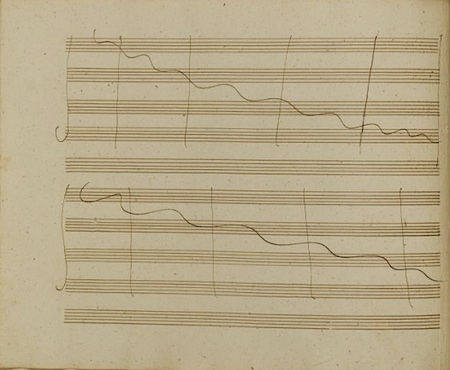
Little ever left me as flabbergasted as my first encounter with Ludwig van Beethoven's Große Fuge, some early morning thirty years ago, when it sounded from the small speaker of a transistor radio in my Amsterdam apartment's kitchen. I wondered who on earth could be the composer that so desperately & violently tried - and failed - to pass to the other side of some sort of a 'tonal looking glass', then temporarily retreated into an almost boring pianissimo, a lighthearted diversion, before, fiercely, getting at it again and again, bumping head on into a wall like a wrecking ball, with its subjects being distorted, stretched, compressed, played upside down, reversed ... until it all just stopped, with a few trivial bars of tonic and dominant; not in resignation, but as if saying: "ok, now you win, but this is not the end of it; one day I will get you, just you wait and see...!"
Written around 1825, as deaf as a post and near the end of his life, the Große Fuge (opus 133) was originally intended as the final of the string quartet in B flat (opus 130) and performed as such at that work's premiere in Vienna, on May 21st, 1826, by the Schuppanzigh Quartet. I am surely not the only one who has fantasized about this particular first performance, im Saale des Vereins, as the last part of a concert (eine von Hrn. Schuppanzigh veranstaltete Abendunterhaltung) which, besides more Beethoven (a piano trio and - von Hrn. Hoffmans gesungen - Adelaïde), included a couple of works by Haydn and Weiss. I suppose Ludwig himself saw the performance, though, deaf as he was, he will not have heard an awful lot of it. The reviewer of the Allgemeine musikalische Zeitung (which is available as a free pdf download at Google Books, see link below) was rather charmed by the other parts of Beethoven's newest work (keywords: ernst, düster, mystisch, bizarr, schroff, capriciös, Muthwillen, Frohsinn, Schalkhaftigkeit), but admitted that he completely failed to understand the quartet's final, the Fuga. It sounded to him wie Chinesisch. He added, however, that this might have been partly due to the considerable problems that Schuppanzigh's string players had, to - literally - come to grips with Ludwig's mega-fugue:
"Wenn die Instrumente in den Regionen des Süd- und Nordpols mit ungeheuern Schwierigkeiten zu kämpfen haben," he wrote, "wenn jedes derselben anders fugirt und sie sich per transitum irregularem unter einer Unzahl von Dissonanzen durchkreuzen, wenn die Spieler, gegen sich selbst misstrauisch, wohl auch nicht ganz rein greifen, freylich, dann ist die babylonische Verwirrung fertig; dann giebt es ein Concert, woran sich allenfalls die Marokkaner ergötzen können, denen bey ihrer hiesigen Anwesenheit in der italienische Oper nichts wohlgefiehl als das Accordiren der Instrumente in leeren Quinten, und das gemeinsame Präludieren aus allen Tonarten zugleich." (Allgemeine musikalische Zeitung, 28 (19), May 1826)
...
I took a recording of this Große Fuge as my subject for an experiment that I started early October and that went on throughout November and most of the month of December, looking for sounding answers to a question that had occurred to me while reading MP3: The Meaning of a Format (Sign, Storage, Transmission),
Jonathan Sterne's recent history of the mp3, and writing a review of the book for the Dutch Gonzo Circus Magazine. (Muziek voor Kattenkoppen, Gonzo Circus Magazine #112. Here is a link to the online teaser for the review.)
This is the question that I asked myself: what would happen if I fed the output of an mp3 encoder back into itself, and then continued to do so? Make an mp3 of the mp3, then an mp3 of the mp3 of the mp3, an mp3 of the mp3 of the mp3 of the mp3, and so on...?
It could have been the case that an mp3 encoder recognizes the fact that you are feeding it a digital file that already is an mp3, switches to 'identity' mode, and spits out a copy of that what you put into it. But that is not the case, or at least not for the encoder that I use (the one that comes with Apple's iTunes).
To get a first impression, I began by iterating the mp3-ification of a short sound byte that happened to be on my hard drive, feeding one encoding after the other back into iTunes. It was not yet the Große Fuge, but a snippet also from a Beethoven string quartet (the beginning of the fourth movement of opus 135, his very last work) that earlier this year I used as a sample in my recording with La Vie de Bohème of 'Het Moet Zo Zijn' (based on pages 133-135 of my ULTRA book and in the near future to be released as a pink 7" on the Dutch Smikkelbaard label. The reason I picked it, was purely pragmatic: it was short, just a bit over 3 seconds, so repeated conversion could be done relatively quick.)

One thing that does not happen when you convert an mp3-file into a next mp3-file: it will not further reduce the size. All iterations are just as big (or small) as the first generation mp3. So on that level the algorithm does act as an identity. The algorithm, however, continues to modify the sound. The modifications built up rather slowly, but, eventually, become pretty dramatic. Here is a screenshot of the waveform of (one channel of) the original file, followed by that of 8 iterated iTunes mp3-conversions: 10 times, 50 times, 100 times, 200 times, 500 times, 1000 times, 2000 times and, finally, 5000 times.
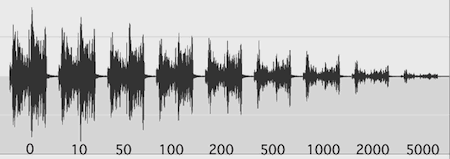
As you can see, the sound is gradually disappearing. When you listen to it, you hear how more and more digital artifacts are creeping in and are being amplified, while that what remains to be heard is becoming thinner and thinner, softer and softer. After a couple of thousand iterations, most of the body of the sound is scraped off and hollowed out, even though you can still hear the contours of the piece in what is left. Listening to these fragments in succession feels as if someone is pushing ever thicker wads of cotton into your ears. Or, well yes, it is as if with each step you are losing more of your hearing.
It is like slowly growing deaf.
When you take things even further, after some 15000 iterations, and unless you change the vertical scale of the graph, the waveform appearing in your audio editor has become little more than a straight line, and you will be hardly able to hear anything at all. Unless, that is, you blow it up with something like a 'sonic microscope'. For this I used the (peak) normalization option available in Sound Studio, the basic audio editor that since many years I use for pretty much all of the audio work on my MacBook.
The SoundCloud player below lets you listen to the original 'Es muß sein' audio, the eight, unmodified, mp3-iterations, and normalized versions of the 10.000th, the 20.000th and the 27.500th iteration. In these ultimate steps you hear how the 'attack' of the fragment becomes a loud and nasty noisy 'crack', while the sound of the strings starts resembling that of a pipe organ, a pan flute, or of someone blowing into a set of tuned bottles. In the 27.500th iteration so much of the high and low end is lost, that what you start hearing is no longer the original piece, but something like a 'melodic envelop' thereof.
Of course I did not do all of these 27.500 iterated mp3-encodings by hand. Manually I got as far as a 1000. And that took almost 6 weeks: I only spent ten, twenty minutes doing this every other day or so, as it's of course something that's horrendously boring to do. But when I eventually had gotten as far as a 1000 iterations, it seemed that results had only just started to get interesting. Interesting enough to want to iterate the mp3-encoding of a more substantial sound file, and take it much further than a mere 1000 times. Which, of course, would be absolutely ridiculous to try to do by hand. It got me thinking whether there was not someone I could ask to help me program a 'recursive mp3 encoder': you input an audio file and some number, say n, and out comes the result of an n-fold iteration of the conversion to mp3. But then I remembered that the Macintosh system has a thing called Applescript, which allows you to automatize repetitive tasks, just like this 'iterative mp3-encoding'. Surely not as elegant and as fast as a custom made application, but fast enough to be able to get on with the job. (You let the computer do the boring and time-consuming work for much of the day and night, while you spend your time in a more useful way; like earning money, playing the piano, reading or writing a book, eating or sleeping.) I had never used Applescript before, but the short afternoon that I spent, googling my way into finding out how to get this to function, was well worth spending. ( ** )
The script worked like a charm. It allowed me to push the number of iterations of the mp3-encoding of 'Es muß sein' up to 27.500 in just a couple of days.
After that I was ready for the real thing, ready to attack the Große Fuge...
Here is a screenshot of (one channel of) the waveform of the original digital (aiff) file. ( *** )

And below is a screenshot of what remained of the waveform of the A-part of the file (corresponding to measures 30-158 in the score), after 30.000 iterated mp3 encodings (without adjustment of the vertical scale; the spike towards the end is a horribly sharp 'click' that built up in strength in the course of the iterations and that, for the continuing health of your hearing, I recommend that you never ever listen to over headphones that are adjusted to the almost absent volume of the rest)...

The following four pictures show spectrograms for this same A-part: of the original file, after 2400 iterations, after 15.000 iterations and after 30.000 iterations. (Made with the wonderful and free Sonic Visualiser program.)
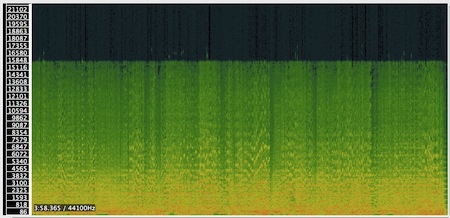 | 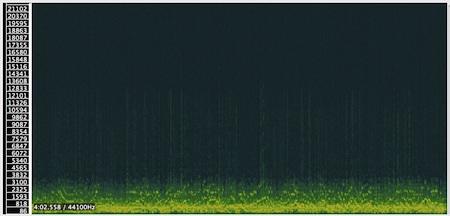 |
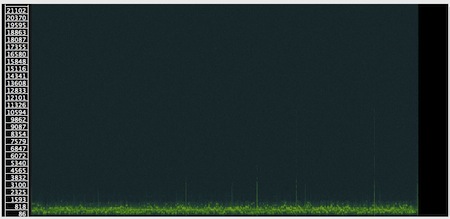 | 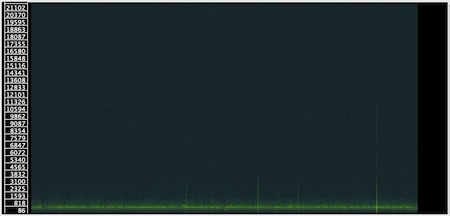 |
The whole thing appears to be converging to a narrow frequency band around 800 Hz, which, in a normalized version of the audio file obtained after 30000 iterations, contains pretty much all of the sound that remains: it is like a tinnitus, a noisy whistling, continuously undulating somewhere around 800 Hz. It is possible that a close-up study of the mp3-encoding algorithm will reveal that its iterated application to any audio file eventually converges to this or a similar frequency band, but to me it was a surprise that the result actually sounded a lot like an everlasting thinned out reverberation of the Große Fuge's four opening measures:
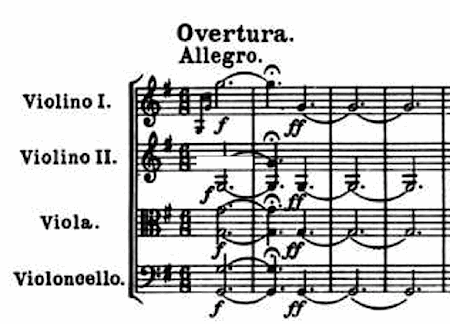
This is why I let Ernst, the first track of Große_Fuge.mp30000, begin with these opening measures of the original audio file, immediately followed by a number of 'whistlings' lifted from the normalized version of the 30.000th mp3 iteration of the A-part of the file, and a few quiet, short bursts of a 800 Hz triangular wave tone. Ernst then continues with a repeated rendering of measures 17-21, in increasing powers of mp3, leading, in steps of a couple of hundreds, from the original version to the 2400th iteration. This is followed by the (normalized) 2400th mp3 iteration of - an edited version ( **** ) of - part B of the original audio file, which, in the score, corresponds to measures 453-514. The first track ends with a repetition of measures 511-514, again in increasing powers of mp3, now going from the 2400th iteration down (for, indeed, sonically it is a descent) to the 30.000th iteration...
The second track is called Düster. It is the normalized version of the 2400th iteration of part A of the audio file, corresponding to measures 30-158. Again, I edited the original somewhat (which to me is like giving it a 'signature'), but this time only very slightly so.
The third track, Muthwillig, is a bridge from the first two to the final three tracks. The final tracks use powers of mp3 that - unlike the 2400th power that dominates in tracks 1 and 2 (which still lets you follow most of the music, even though it sounds as if it is bubbling somewhere under water, at the bottom of a pool) - have wiped out pretty much all of what the original track sounded like. You can also think of Muthwillig as a little reminder that it's not your ears, nor your equipment, but the very nature of this work that makes all of it sound so soft, so far away, so thin and so very lo-fi...
Capriciös, the fourth track, was edited from a normalized version of the 30.000th mp3 iteration of the C-part of the audio file, corresponding to measures 581-621.
The fifth track, Schalkhaftig, is my personal favorite in the small bag of fruits harvested from of this experiment in mp3 iteration. It basically is a normalized version of the 15.000th iteration of the A-part, with some edits.
Bizarr is the sixth and final track of Große_Fuge.mp30000. The 30.000th iteration of the A-part, after (repeated) normalization and removal of the horrible spikes that had been building up along the way, lets you hear little more than the noisy, waving whistling in the frequency band around 800 Hz, that I mentioned above. For the album's ultimate track I therefore applied an equalization to the normalized 30.000th iteration, that, essentially, removes this frequency band, and amplifies what remained of the low and high frequencies. The result is a dense flow of digital artifacts. But if you listen carefully, within this bubbling electronic stream, you can still make out the outlines of the fugue.
It is floating in the depths, like a ghost.
...
[ This embedded player lets you listen to all of Große_Fuge.mp30000. To download the digital album, jump over to Bandcamp. Happy 2013! ]
...
Other examples of recursive mp3-encoding
[ added January 3th, 2013: C. Reider (aka vuzhmusic) sent me a link to an earlier example of iterations of an mp3-encoding. In his Recursive MP3 Encoding (for Tobias Reber) you can listen to 20 successive iterations of the 128 kbps 44.1 kHz mp3 encoding of a ten second blast of white noise... ]
[ added January 4th, 2013: In hindsight it is of course sort of obvious that when researching and writing his book on the mp3 format, Jonathan Sterne also considered the recursive application of the codec. Jonathan sent me a link to a page on his web site dedicated to the subject, which, very appropriately (and not so much something that I forgot to mention, as something I left out to not make the above article even longer than it already was), considers the iterative encoding of a sound file as a digital equivalent of Alvin Lucier's classic analog recursive 'encoding' piece, "I am sitting in a room". It is thus that in the summer of 2010, after having sent out his manuscript for 'MP3', Jonathan was sitting in a room, compressing, running [his] recording through an mp3 encoder again and again... Another fun example of recursive encoding, also linked on Jonathan's page, is Cory Arcangel's 666, the result of 666 iterated mp3 encodings of Iron Maiden's Number of the Beast. ]
[ added January 4th, 2013: About two years ago, during a Music Hack Day in Berlin, Shoudio's Roeland Landegent did it to Rebecca Black. "Every 5 seconds we passed the music n+1 times through the mp3 encoder/decoder, I think," Roeland explained. "Or no, wait, what we did was something like 30 versions, which we then cut up, using 5 seconds of version 1, then 5 seconds of version 2, 5 seconds of the following, and so on..." Listen to the result: Rebecca Black LamerSoxxed. ]
[ added January 11th, 2013: Tobias Reber - whose observations on what 'SoundCloud compression' (according to SoundCloud, it is just 128kbps mp3 conversion) does to uploaded tracks, inspired vuzhmusic's example of recursive mp3-encoding - told me that Markus Reuter applied the technique on his solo album Trepanation (2006). "It was used in the pieces called Accumulations," clarified Markus, "so, in The Key to Conscience, Beat and Number of the Mind. I used a batch processor to run ca. 100 iterations on the original composition. The files were then played back at half-speed and dynamically compressed to magnify the artifacts. Hi-quality delays and reverb was added to this to present the artifacts in a more 'polished' way. The other tracks on the album also use recursive mp3 encoding, but on certain elements of the compositions only." ]
[ added December 07th, 2013: On May 27th 2009 American composer and video artist Patrick Liddell uploaded a short video (in mp4 format) of him speaking a variation on Alvin Lucier's I am sitting in a room text to YouTube. He then downloaded the YouTube-encoded version, transcoded that again to mp4, and re-uploaded this next generation version to YouTube. Between then and May 27th 2010, he repeated this process 1000 times. The clip embedded below summarizes the process in a little under three minutes. It has a mighty decent number of views on YouTube. Curious that it took me so long to stumble upon it; today, via kottke.org. ]
[ added April 14th, 2014: In his project The Ghost in the MP3, Ryan Maguire asks the very interesting question what precisely is lost by using mp3-compression. He considers and develops techniques to recover the sounds that are deleted by the codec. In his track "moDernisT" you hear the sounds thus salvaged from Suzanne Vega's song Tom's Diner, one of the pieces that were used in the listening tests during the development of the MP3 encoding algorithm. ]
...
notes __ ::
(*) Jeremy Davies - Rose Alley (2009)
..... [
^ ]
(**) For those of you who'd like to try their hands at some recursive mp3-encoding themselves, below is a screenshot of the script. It starts by telling iTunes to add the file 'gfmp2a_conv.mp3' (which is in the map 'Unknown Albumm' in 'iTunes Media/Music/Unknown Artist'), to its playlist 'esmusssein', and convert it to mp3. The converted file is saved in the map 'iTunes Media/Music/Unknown Artist/Unknown Album' (you can modify this default location and set the conversion format that you want in the iTunes preferences; the format I have been using all along is that of the standard 128kbps 44.1 kHz stereo mp3). iTunes then deletes the original file from the playlist, and the Finder moves it from the map 'Unknown Albumm' to your computer's trash. The converted file now becomes the new original file, by instructing the Finder to move it from the map 'Unknown Album' to the map 'Unknown Albumm', after which the whole thing repeats itself. (This may seem a bit complicated, but it avoids the trouble of getting Applescript to rename the file.) The script in the screenshot does this a 1000 times (which on a MacBook, for a track with a duration of about 6 minutes, took something between four and six hours). At the end, the file 'gfmp2a_conv.mp3' in 'Unknown Albumm' is a 1000 times iterated mp3-encoding of the file 'gfmp2a_conv.mp3' that you started with. This initial file is now in your bin, together with the 999 other intermediate files. (I never did more than 1000 iterations in one go; running the procedure does heat up a MacBook quite a bit. After a while it has the cooling fan blowing at full speed, so I thought it wise to give the computer a bit of a rest every now and then. You will also want to watch your disk space. Generating a 1000 successive mp3 versions of a 6Mb mp3 file adds 6Gb to your hard drive, though it is of course possible to extend the script with an instruction that will empty the trash every once in a while.)
[
^ ]
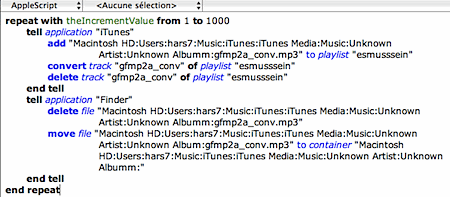
(***) The recording I used is one by the Alban Berg Quartet. I have to admit that I did not worry too much about copyright issues, as I do think the use of the recording in the context of this experiment can be considered a case of 'fair use'. If you ever stumble upon it, and hear it, guys ... enjoy! [
^ ]
(****) If you read music, you will have no trouble finding out precisely how I modified the original, by downloading a pdf of the score of the piece, and reading along. [
^ ]
tags: Beethoven, Große Fuge, mp3, feedback, recursive encoding
# .432.
comments for Große_Fuge.mp30000 ::
|
Comments are disabled |